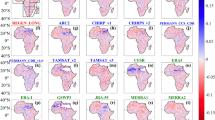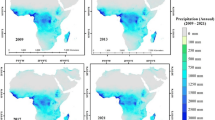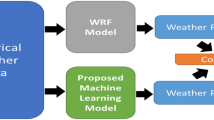Abstract
Temporal changes of the global surface temperature have been used as a prominent indicator of global climate change; therefore, making dependable forecasts underlies the foundation of sound environmental policies. In this research, the accuracy of the Seasonal Autoregressive Integrated Moving Average (SARIMA) Stochastic model has been compared with the Support Vector Regression (SVR) and its merged type with Firefly optimization algorithm (SVR-FA) as a meta-innovative model, in long-term forecasting of average monthly temperature. For this, 5 stations from different climates of Iran (according to the Extended De Martonne method) were selected, including Abadan, Anzali, Isfahan, Mashhad, and Tabriz. The data were collected during 1951–2011, for training (75%) and testing (25%). After selecting the best models, the average monthly temperature has been forecasted for the period 2012–2017. The results showed that the models had better performances in Extra-Arid and Warm (Abadan) and after that Extra-Arid and Cold (Isfahan) climate, in long-term forecasting. The weakest performances of the models were reported in Semi-Arid and Cold climate, including Mashhad and Tabriz. Also, despite the use of the non-linear SVR model and its meta-innovative type, SVR-FA, the results showed that, in the climates of Iran, the linear and classical SARIMA model still offers a more appropriate performance in temperature long-term forecasting. So that it could forecast the average monthly temperature of Abadan with root mean square error (RMSE) = 1.027 °C, and Isfahan with RMSE = 1.197 °C for the 6 years ahead. The SVR and SVR-FA models also had good performances. The results of this checking also report the effectiveness of the merging SVR model with the Firefly optimization algorithm in temperature forecasting in Iran’s climates, so, compared with the SVR model, it is suggested to use SVR-FA for temperature forecasting.






Similar content being viewed by others
References
Asamoah-Boaheng M (2014) Using SARIMA to forecast monthly mean surface air temperature in the Ashanti Region of Ghana. Int J Stat Appl 4(6):292–298
Ashrafzadeh A, Malik A, Jothiprakash V, Ghorbani MA, Biazar SM (2018) Estimation of daily pan evaporation using neural networks and meta-heuristic approaches. ISH J Hydraul Eng:1–9
Bassam A, May Tzuc O, Escalante Soberanis M, Ricalde LJ, Cruz B (2017) Temperature estimation for photovoltaic array using an adaptive neuro fuzzy inference system. Sustainability 9(8):1399
Box GE, Jenkins GM (1976) Time series analysis: forecasting and control revised ed. Holden-Day
Deo RC, Ghorbani MA, Samadianfard S, Maraseni T, Bilgili M, Biazar M (2018) Multi-layer perceptron hybrid model integrated with the firefly optimizer algorithm for windspeed prediction of target site using a limited set of neighboring reference station data. Renew Energy 116:309–323
Dibike YB, Coulibaly P (2006) Temporal neural networks for downscaling climate variability and extremes. Neural Netw 19(2):135–144
Dibike YB, Velickov S, Solomatine D, Abbott MB (2001) Model induction with support vector machines: introduction and applications. J Comput Civ Eng 15(3):208–216
EL HOUARI MB, ZEGAOUI O, ABDALLAOUI A (2015) Prediction of air temperature using multi-layer perceptrons with Levenberg-Marquardt training algorithm. Parameters 1:11
Ghorbani MA, Shamshirband S, Haghi DZ, Azani A, Bonakdari H, Ebtehaj I (2017) Application of firefly algorithm-based support vector machines for prediction of field capacity and permanent wilting point. Soil Tillage Res 172:32–38
Ghorbani MA, Deo RC, Yaseen ZM, Kashani MH, Mohammadi B (2018) Pan evaporation prediction using a hybrid multilayer perceptron-firefly algorithm (MLP-FFA) model: case study in North Iran. Theor Appl Climatol 133(3-4):1119–1131
Goswami K, Hazarika J, Patowary AN (2017) Monthly temperature prediction based on ARIMA model: a case study in Dibrugarh station of Assam. Ind Int J Adv Res Comp Sci 8(8)
Goyal MK, Bharti B, Quilty J, Adamowski J, Pandey A (2014) Modeling of daily pan evaporation in subtropical climates using ANN, LS-SVR, Fuzzy Logic, and ANFIS. Expert Syst Appl 41(11):5267–5276
Hayati M, Mohebi Z (2007) Temperature forecasting based on neural network approach. World Appl Sci J 2(6):613–620
Isazadeh M, Biazar SM, Ashrafzadeh A (2017) Support vector machines and feed-forward neural networks for spatial modeling of groundwater qualitative parameters. Environ Earth Sci 76(17):610
Jha SK, Hayashi K (2014) A novel odor filtering and sensing system combined with regression analysis for chemical vapor quantification. Sensors Actuators B Chem 200:269–287
John C, George U, Chukwuemeka OS (2014) Time series analysis and forecasting of monthly maximum temperatures in south eastern Nigeria. Int J Innov Res Dev 3(1)
Karevan Z, Feng Y, Suykens JA (2016, April) Moving least squares support vector machines for weather temperature prediction. In: Proceedings of the European Symposium on Artificial Neural Networks, Brugge, pp 27–29
Kavousi-Fard A, Samet H, Marzbani F (2014) A new hybrid modified firefly algorithm and support vector regression model for accurate short term load forecasting. Expert Syst Appl 41(13):6047–6056
Mehr AD, Nourani V, Khosrowshahi VK, Ghorbani MA (2019) A hybrid support vector regression–firefly model for monthly rainfall forecasting. Int J Environ Sci Technol 16(1):335–346
Mills TC (2014) Time series modelling of temperatures: an example from Kefalonia. Meteorol Appl 21(3):578–584
Moazenzadeh R, Mohammadi B, Shamshirband S, Chau KW (2018) Coupling a firefly algorithm with support vector regression to predict evaporation in northern Iran. Eng Appl Comput Fluid Mech 12(1):584–597
Mohammadi K, Shamshirband S, Danesh AS, Zamani M, Sudheer C (2015) Horizontal global solar radiation estimation using hybrid SVM-firefly and SVM-wavelet algorithms: a case study. Nat Hazards:1–18
Musa Y (2014) Modeling an average monthly temperature of Sokoto Metropolis using short term memory models. Int J Acad Res Bus Soc Sci 4(7):382
Naganna SR, Deka PC, Ghorbani MA, Biazar SM, Al-Ansari N, Yaseen ZM (2019) Dew point temperature estimation: application of artificial intelligence model integrated with nature-inspired optimization algorithms. Water 11(4):742
Pai PF, Hong WC (2007) A recurrent support vector regression model in rainfall forecasting. Hydrol Proc: Int J 21(6):819–827
Pérez-Vega A, Travieso CM, Hernández-Travieso JG, Alonso JB, Dutta MK, Singh A (2016, April) Forecast of temperature using support vector machines. In: Computing, communication and automation (ICCCA), 2016 International conference on. IEEE, pp 388–392
Radhika Y, Shashi M (2009) Atmospheric temperature prediction using support vector machines. Int J Comp Theor Eng 1(1):55
Rahimi J, Ebrahimpour M, Khalili A (2013) Spatial changes of extended De Martonne climatic zones affected by climate change in Iran. Theor Appl Climatol 112(3-4):409–418
Romilly P (2005) Time series modelling of global mean temperature for managerial decision-making. J Environ Manag 76(1):61–70
Salas JD, Delleur JR, Yevjevich V, Lane WL (1988) Applied modeling of hydrologic time series. Water Resor. Pub, Littleton
Shereef IK, Baboo SS (2011) A new weather forecasting technique using back propagation neural network with modified Levenberg Marquardt algorithm for learning. Int J Comp Sci Issues (IJCSI) 8(6):153
Shi XIAOYU, Huang QIANG, Chang JIANXIA, Wang YIMIN, Lei J, Zhao J (2015) Optimal parameters of the SVM for temperature prediction. Proc Int Assoc Hydrol Sci 368:162–167
Suzuki Y, Kaneda Y, Mineno H (2015) Analysis of support vector regression model for micrometeorological data prediction. Comp Sci Inform\ Technol 3(2):37–48
Taylor KE (2001) Summarizing multiple aspects of model performance in a single diagram. J Geophys Res Atmos 106(D7):7183-7192
Vapnik, V. N., & Chervonenkis, A. J. (1974). Theory of pattern recognition.
Yang XS (2009) Firefly algorithms for multimodal optimization. In: International symposium on stochastic algorithms. Springer, Berlin, Heidelberg, pp 169–178
Yang, X. S., & He, X. (2013). Firefly algorithm: recent advances and applications. arXiv preprint arXiv:1308.3898.
Ye L, Yang G, Van Ranst E, Tang H (2013) Time-series modeling and prediction of global monthly absolute temperature for environmental decision making. Adv Atmos Sci 30(2):382–396
Yoon H, Jun SC, Hyun Y, Bae GO, Lee KK (2011) A comparative study of artificial neural networks and support vector machines for predicting groundwater levels in a coastal aquifer. J Hydrol 396(1-2):128–138
Author information
Authors and Affiliations
Corresponding author
Additional information
Publisher’s note
Springer Nature remains neutral with regard to jurisdictional claims in published maps and institutional affiliations.
Rights and permissions
About this article
Cite this article
Aghelpour, P., Mohammadi, B. & Biazar, S.M. Long-term monthly average temperature forecasting in some climate types of Iran, using the models SARIMA, SVR, and SVR-FA. Theor Appl Climatol 138, 1471–1480 (2019). https://doi.org/10.1007/s00704-019-02905-w
Received:
Accepted:
Published:
Issue Date:
DOI: https://doi.org/10.1007/s00704-019-02905-w




